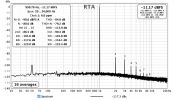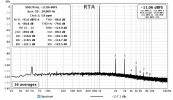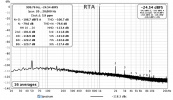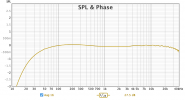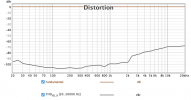This review was updated September 21, 2023. Main change was the use of the E1DA Scaler to fix the impedance issues that is evident when using the E1DA ADC alone.
This is an attempt to make a small review with measurements of the Muffsy MM phono preamplifier. It is a DIY kit so it is far from something that everyone can and will buy. What makes it interesting is that it is one of the few phono preamplifiers where you can modify both capacitance (C) and load (R). The version that is reviewed here is the PP3 rev A which is different from the the current one (PP4). The difference between them is a better layout of the PSU and main board of the PP4 to reduce noise further. Price with main board, PSU and back panel is 153 dollar. To that you need the box and an AC adapter.
 www.muffsy.com
www.muffsy.com

Measuring a phono pre was harder than I thought. The equipment was a Cosmos E1DA grade B, mono mode, together with two series-attached adjustable passive Monacor ILA-1020 dampers (- 20 dB, together or separate), and the E1DA Scaler (updated review). A D10s with an USB-isolator was generating signals and everything was hooked up to a Macbook on battery. The Muffsy had gain "high", about 44 dB in all tests.
The first two distortion measurements were made with ≈5 mV input signal, left and right channel:


In this setting the noise was -76 dB, but virtually no distorsion could be observed. Good result. (Note that the updated Muffsy should have less noise.)
Looking at headroom at 1 kHz, the Muffsy turned out to be excellent. Clipping above 120 mV. (Here I used the 43V input of the E1DA, so distortion is higher due to the impedance mismatch.)

Distortion vs frequency was very low:

Lastly, the RIAA curve accuracy. When you are a DIYer, you also have the option to buy a little extra capacitors and match them better to the ideal values. This unit I have does have better matched capacitors than would be expected from random choice. -1 dB was at 10 Hz and variations were within +/- 0.1 dB from 50 Hz- 20 kHz. Excellent result.

In conclusion, an excellent MM preamplifier with adjustable gain and load (R & C). However, it's DIY so not for everybody. Notably, the Cosmos ADC is not ideal for measurements without a buffer. This review was updated with E1DA Scaler to get better result. Distortion was generally lower with the Scaler and the frequency response was more linear in the bass region. I have kept the old figures as attachments.
This is an attempt to make a small review with measurements of the Muffsy MM phono preamplifier. It is a DIY kit so it is far from something that everyone can and will buy. What makes it interesting is that it is one of the few phono preamplifiers where you can modify both capacitance (C) and load (R). The version that is reviewed here is the PP3 rev A which is different from the the current one (PP4). The difference between them is a better layout of the PSU and main board of the PP4 to reduce noise further. Price with main board, PSU and back panel is 153 dollar. To that you need the box and an AC adapter.
Muffsy DIY Phono Kits
The Muffsy Phono Kits are complete hifi kits for record players for all cartridges ranging from LOMC to HOMC and MM.
Measuring a phono pre was harder than I thought. The equipment was a Cosmos E1DA grade B, mono mode, together with two series-attached adjustable passive Monacor ILA-1020 dampers (- 20 dB, together or separate), and the E1DA Scaler (updated review). A D10s with an USB-isolator was generating signals and everything was hooked up to a Macbook on battery. The Muffsy had gain "high", about 44 dB in all tests.
The first two distortion measurements were made with ≈5 mV input signal, left and right channel:
In this setting the noise was -76 dB, but virtually no distorsion could be observed. Good result. (Note that the updated Muffsy should have less noise.)
Looking at headroom at 1 kHz, the Muffsy turned out to be excellent. Clipping above 120 mV. (Here I used the 43V input of the E1DA, so distortion is higher due to the impedance mismatch.)
Distortion vs frequency was very low:
Lastly, the RIAA curve accuracy. When you are a DIYer, you also have the option to buy a little extra capacitors and match them better to the ideal values. This unit I have does have better matched capacitors than would be expected from random choice. -1 dB was at 10 Hz and variations were within +/- 0.1 dB from 50 Hz- 20 kHz. Excellent result.
In conclusion, an excellent MM preamplifier with adjustable gain and load (R & C). However, it's DIY so not for everybody. Notably, the Cosmos ADC is not ideal for measurements without a buffer. This review was updated with E1DA Scaler to get better result. Distortion was generally lower with the Scaler and the frequency response was more linear in the bass region. I have kept the old figures as attachments.
Attachments
Last edited:

